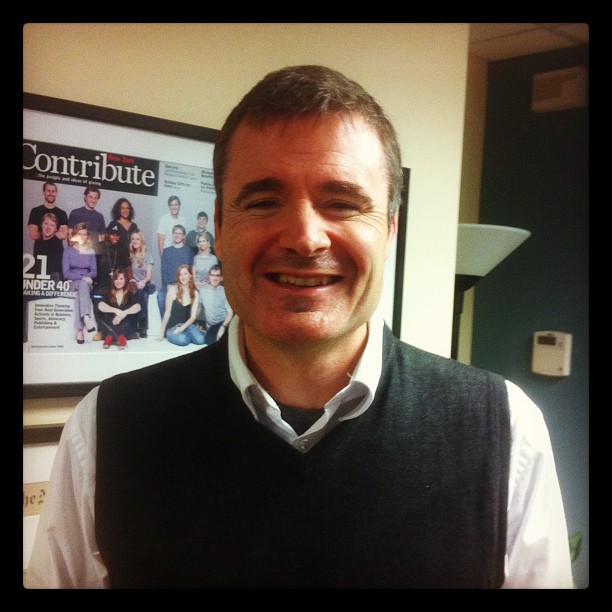 Jad Daley with the Trust for Public LandPhoto: Hanna Welch
Jad Daley with the Trust for Public LandPhoto: Hanna Welch
All right, we know that no place with hundreds of thousands of inhabitants deserves to be described in these terms — but let’s face it, some cities are known for being dumps. Yet every dump can be cleaned up. Few understand this better than Jad Daley, director of the climate conservation program at the Trust for Public Land, a nonprofit that acts as a “conservation real estate agent,” helping to procure parks and green spaces for public use.
The Trust is notable among green groups in that it works in cities, not just the big wilderness. It has helped protect dozens of parks in New York City, land along the Los Angeles River, and many green spots in between. The group’s motto: Conserving land for people. So when Daley visited Grist’s offices this week, we wanted to know what it takes for a town to lose its dump-hood.
Daley was game — but first, he wanted to explain the connection between his work and the climate by offering up a few choice statistics:
- On average, a resident of New York City creates 13,448 fewer pounds of globe-warming carbon dioxide each year than someone who lives in the surrounding suburbs.
- Residents of Chicago generate 75 percent less emissions from transportation than residents of Kane County, Ill., on the outskirts of the city.
- Five to 10 percent of the energy we spend cooling buildings in cities is attributable to the urban heat island effect, which urban parkland can mitigate.
Yow. Let’s all move back to the city and start planting trees.
The question is, which city? We asked Daley to surprise us with the names of three up-and-coming cities that we wouldn’t normally think of as particularly livable or green. Here was his on-the-spot response:
 Chattanooga in the 1950sPhoto: c/o Brent Moore, SeeMidTN.com1. Chattanooga, Tenn.
Chattanooga in the 1950sPhoto: c/o Brent Moore, SeeMidTN.com1. Chattanooga, Tenn.
This former industrial burg tucked into the Tennessee hills hit rock bottom in 1969, when the federal government declared that it had the worst air quality in the nation. Over time, the city cleaned up its air with help from locally manufactured smoke stack “scrubbers.” It made a serious comeback in the 1990s, rebranding itself as “the environmental city” and breathing new life into its downtown and the Tennessee River waterfront. The Trust for Public Land has been involved in creating a network of greenways along the river and its tributaries.
One of Chattanooga’s greatest triumphs came in the mid-1990s, when neighborhood groups rallied to create the Safewalk, a greenway that connects the once neglected Alton neighborhood to schools, grocery stores, and a network of other parks and trails. The Safewalk brought the green revival to one of the city’s poorest corners, and is credited for helping spark an ongoing economic and community revival.
The Cuyahoga River on firePhoto: Cleveland Press Collection, Michael Schwartz Library, Cleveland State University2. Cleveland, Ohio
In the 1960s, ’70s, and ’80s, Cleveland was a hellhole. The city saw race riots, white flight to the suburbs, and the headline-grabbing 1969 incident in which the Cuyahoga River, laced with all manner of industrial funk, caught fire. (It wasn’t the first time. And you thought residents living around fracking operations were the first people to figure out how to burn water.) In the mid-1980s, one in seven Cleveland residents was out of work.
Fast forward 25 years, and the Cuyahoga is a popular spot among boaters. People actually swim in the thing. The Trust for Public Land recently helped acquire riverside land that will become the Rivergate Park, future home of the Cleveland Rowing Foundation. Elsewhere, efforts are underway to revive an “emerald necklace” of parks that encompasses more than 22,000 acres surrounding the city. And there’s an economic revival stirring as well.
Traffic in AtlantaPhoto: Matt Lemmon via Flickr3. Atlanta, Georgia
Wha? Really? Atlanta is the poster child of sprawl. It has some of the worst traffic and the worst air quality in the nation. Plus — whoops — it’s almost out of water. Still, Daley insists Atlanta is on the up and up.
True enough, there have been some heroic efforts of late to breathe new life into neighborhoods in the urban core. And now, the Trust for Public Lands is working with local groups to create the Belt Line, a string of parks and trails built on an abandoned railway encircling downtown and midtown Atlanta. The plan, which includes proposals for light rail and street cars, has been rolled into a massive regional transportation initiative, to be voted on next year, and is seen as a way to help attract residents back to the city center, alleviating traffic to and from the fringes in the process.
We’re withholding judgment on this one. But hey, if Choo-choo Town and the Mistake on the Lake can be born again, who’s saying that Hotlanta can’t clean up its act as well.
Got a favorite dump you’d like to see cleaned up? A hometown that’s already turned from an ugly duckling to a swan? Drop us a note below. We’d love to hear about it.



